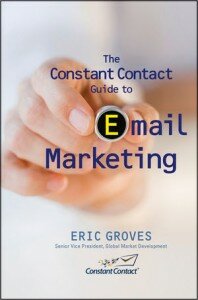Weber Media Partners | Impressions Through Media
Conversational Marketing in the Age of Social Media
- Home
- About This Blog
- Contact
- Sitemap
Archive for the ‘email marketing’ Category
In Praise of Writing Effective Email Newsletters
Author: Debbie Hemley5 Dec
 It’s that time of year again—holiday music on the radio, piped into stores. Decorations lining the shelves, and gift items flashed before you almost everywhere you look.
It’s that time of year again—holiday music on the radio, piped into stores. Decorations lining the shelves, and gift items flashed before you almost everywhere you look.
One of the things I love about this time of the year is the Best Lists–best books of 2009, best music, gift ideas, places to travel, places to eat, etc.
I’ve read a long list of wonderful books about social media, marketing, and all the advances in technology in 2009–and written a number of posts about them. As the year is rolling towards 2010 and into a new decade the pile of books waiting to be read has grown exponentially.
This week I’ve had the pleasure to read Eric Groves new book The Constant Contact Guide to Email Marketing. Eric is the Senior Vice President, Global Market Development at Constant Contact and writes with great knowledge and authority on the topic.
I was interested in the book for two main reasons:
1) With all the hubbub about Facebook, Twitter, Blogs, etc., Email Marketing has been losing the ranking it deserves. At times its become the forgotten stepchild of business marketing.
- 1 Comment
- Filed under: books, email marketing, social media marketing
Suffering from Information Overload?
Author: Debbie Hemley23 Aug
“Can everyone just stop whining about information overload?”, is a great opening line by Paul Hemp in his piece, “Death by Information Overload” from the September 2009 issue of Harvard Business Review.
It’s the kind of line which grabs us by our smartphone (or dumbphone, if the case may be), and sounds a relentless ringtone until we wake up and answer the call to action.
Sure, I’ve thought all about the whining, too, and how tiresome information overload has become. Let’s face it, it’s either shape up or ship out.
Shaping up is exactly what Paul Hemp offers in this candid portrait of people who are just eking to get by. Hemp acknowledges that in the knowledge economy, information is our most valuable commodity, but some of us may be struggling with information inundation.
(more…)
- 3 Comments
- Filed under: email marketing, social media marketing
Building and Engaging Customer Relationships A Character at a Time
Author: Debbie Hemley29 Dec
 Can you communicate with your customers in 140 characters? Kate Kaye reports in her post today on Clickz how more and more companies are using Twitter for engaging in customer service, branding, and corporate culture-building.
Can you communicate with your customers in 140 characters? Kate Kaye reports in her post today on Clickz how more and more companies are using Twitter for engaging in customer service, branding, and corporate culture-building.
Kaye gives examples of a number of brands using Twitter but the most notable of the bunch is , the online shoe store. Zappos CEO Tony Hsieh, says “It’s not about marketing. It’s about building relationships, and it’s about being real and transparent.” Zappos has over 26,000 followers on Twitter, and over 400 staff members tweet, too. See Hsieh’s, Beginner’s Quick Start Guide and Tutorial to Using Twitter.
Also worth noting is Marketing Executives Networking Group’s (MENG) November 2008 survey, which reports 85.4% of the executives cited customer engagement as the main benefit of social media marketing.
Olle Bälter a contributor to William Jones’ book Keeping Found Things Found: The Study and Practice of Personal Information Management, expands upon Guy Kawasaki’s post about effective emailing. Bälter writes that it’s not uncommon for people to receive as many as 60 incoming email messages a day, and that recipients will most likely read and respond to short, clear messages. He suggests using the subject line effectively–possibly pose your question in the field, and avoid unnecessary text in the message.
With so much information vying for our attention, less is often more. For 2009, if you’re not already using Twitter, you might consider giving it a try. See if you can gain the attention of your customers, and build stronger relationships with 140 character messages. Experiment too with writing more concise email messages. If you already have experiences you’d like to share, tell us about them.
- 1 Comment
- Filed under: email marketing, social media marketing
Email Newsletters: Too Young to Retire
Author: Debbie Hemley18 Aug
Newsletters feel personal because they arrive in your inbox;
you have an ongoing relationship with them.
-Jakob Nielsen, September 30, 2002

Sometimes with the web changing so rapidly, a comment made in 2002, such as the one above by Jakob Nielsen, (whose been called the “guru of web page usability” and “the next best thing to a true time machine”) could sound like ancient history. In my opinion, Jakob Nielsen called a spade a spade.
The focus on web 2.0 and social networking often neglects to mention our old friend, email newsletters —and the importance in continuing to use them as part of a company’s marketing mix.
In a recent Forrester webinar with B2B marketers, Laura Remos and Dan Klein asked their participants, “Which digital, social media tactics do you use currentlv?” 2/3 of the participants rated email newsletters at the top of their list, with webinars following close behind. Only 35% or fewer reported using blogs, online forums, video produced by marketing, podcasts, customer contributed content, or other Web 2.0 tactics.
Emal Newsletter Best Practices
A recent post on the blog, The Email Wars, called email marketing, “the magic ingredient… the critical component to social media. It is the fuel that will drive your campaign or community.” So what about this question regarding email newsletters and how they’re fairing with newer social media? I don’t believe it’s an either or situation. As Nielsen put it so eloquently, email newsletters are personal. That hasn’t changed. In fact, email newsletters compliment and work harmoniously with the company’s website, blog, online forums and other Web 2.0 tactics. They help companies in their efforts to build and maintain relationships, communicate with clients and prospects all at once; or in carefully segmented lists.
To create a successful email newsletter:
1. Develop a schedule, e.g. monthly, quarterly– and stick to it.
2. Remind customers and prospects about what your company has to offer them.
3. Make your newsletter permission-based, always giving the recipient the ability to opt-out.
4. Make the most of the newsletter’s hyperlinks–point readers to your website, blog, facebook page, and any other place where your company has a presence.
5. Expand on a topic you wrote about in your blog (or vice versa).
6. Experiment with new material. Content is still king e.g. your readers may like when you provide how-to articles, review an industry book, include a list of upcoming events.
7. Remember content needn’t be restricted to the written word, it takes many forms–images, videos, podcasts, social networking, social bookmarking, and micro-blogging.
8. Use analytics software for information about newsletter open rates, opt-outs, bounced, number of click-throughs.
9. Set realistic goals. Keep in mind that open rates may vary according to industry e.g. newsletters about marketing, publishing & media and technology typically have open rates between 20%-30%. Newsletters for manufacturing, non-profit, travel, art, government, and religious audiences have been reported as having open rates as high as 40%.
10. Remember your audience, write in a congenial style, avoid jargon. Keep it brief, able to read in a few minutes.
Above all, work with your email newsletter and ensure it’s well integrated into your marketing mix. If it’s gotten old and too predictable, then breathe new life into it.
Whatever you do, please don’t eliminate the email newsletter—it’s much too young to retire.
Tell us—are you using B2B email newsletters? We’re interested in hearing about your experiences integrating them into your social media marketing mix.
- 2 Comments
- Filed under: email marketing, social media marketing
- Subscribe To Feed (RSS)
- Comments (RSS)
- Subscribe via Email




Recent Comments
Do businesses need both?